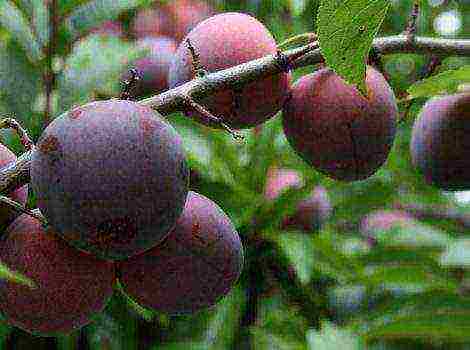Content [show]
If, when choosing cucumber seeds, you pay attention not only to the picture, but also read the inscriptions, you must have come across bags with the inscription "Parthenocarpic hybrid" appearing more and more often in stores.
Parthenocarpic cucumber
Bees are no longer needed
Firstly, some manufacturers are inaccurate by indicating “self-pollinated” in parentheses on the packaging of such cucumber seeds. Parthenocarpic cucumbers are not pollinated at all. Not themselves, not with the help of kind bees and other helpers. They produce fruits without pollination. And the fruits are interesting in that, as you would expect, they do not have seeds. That is, you will not be able to collect your seeds and grow parthenocarpic cucumbers from them next year.
By the way! The fact that these varieties and hybrids can produce flowers and fruits without pollination does not mean that they cannot do so with pollination. Otherwise, how would the breeders get these very seeds for you. Just like in hybrids to preserve the variety, in parthenocarpic cucumbers, seeds are obtained from the fruit, which was formed as a result of manual transfer of pollen from the stamen of one variety to the pistil of another.
Parthenocarpic cucumbers
Benefits of parthenocarpic cucumbers
This interesting cucumber look has many advantages.
Benefits of parthenocarpic cucumbers
In addition to the difficult to pronounce name, cucumbers are different:
- abundant flower formation;
- generous and long-term fruiting;
- truly gigantic growth of lashes (up to two meters);
- excellent taste.
- uniformity in size (the fruits grow almost all the same), which gives them a highly marketable look;
- lack of even the slightest signs of bitterness;
- the possibility of using for preservation and pickling;
- the ability to transport without damage;
- retaining emerald color (cucumbers do not turn yellow);
- long shelf life that does not require special conditions.
In addition, the lack of seeds is also an unusual and interesting detail when eating and preserving the fruit.
What are parthenocarpic cucumbers for?
Growing cucumbers in the open field
At first, these varieties were not grown outdoors. But gradually consumers, amateur gardeners began to plant cucumbers that do not require pollination in open ground. At first it was a temporary greenhouse, the film from which was removed during warming. Then the usual ridge. What if the weather will be bad, it will rain, the bees have a non-flying time.
Planting seedless cucumbers in the open field behaved no worse than in the protected field. And today, many grow varieties of parthenocarpic cucumbers in the open field.
Which varieties of parthenocarpic cucumbers are suitable for outdoor use?
|
Ajax F1 |
Refers to early hybrids. Ripening on the 35th day after germination. Has excellent productivity.It develops powerfully and quickly, throws out long lashes with numerous ovaries. In one node, forms several fruits at once. The size of the fruit is 12 cm (plus / minus 1 cm), pimply, richly emerald. The palatability is considered extra high. Suitable for fresh use, storage, conservation. |
|
Form F1 |
An ultra-ripe hybrid. The collection can begin on the 35th day. It differs from the rest in the size of the fruits - they are small, only 7 cm. Many wait for the cucumbers to grow to the usual 12. This is not necessary - the best taste of the fruits is shown precisely in the size of no more than 8 cm in length. At this time, they have a special juiciness, bright aroma, rich taste. They can also be used successfully for salting. |
|
Angel F1 |
Also from early fruiting. Begins to bear fruit on the 40th - 43rd day from germination. Fruits - no larger than 11 cm. Smooth, thin, gherkin type. Impeccable fresh taste. Suitable for pickling. |
|
Herman F1 |
It is especially popular and loved by summer residents. It has proven itself over the years when grown both in a greenhouse and in the open field. The size of all fruits is 10 cm. Ripens on the 40th day. The taste is excellent. They are ideal for conservation. |
|
F1 advance |
This variety is also early ripening, the first fruits are ready for harvest 40 days after germination. The harvest is impressively bountiful. The variety is new, improved with properties to resist root rot, peronospora, cladosporium and other cucumber diseases. The sizes are standard - 12 cm. The color is also typical - a classic emerald color. They have whitish "thorns". The surface is bumpy. On the palate - sweet, crunchy texture, pronounced characteristic cucumber taste. Stored and pickled. |
|
Christina F1 |
The breeders of the well-known Dutch company "Royal Sluis" have developed this variety especially for growing in open soil. Increased resistance to numerous diseases, early, friendly ripening, immunity to stressful environmental factors, all this makes the hybrid popular and in demand among amateur gardeners. Fruits are 11 cm in size. The taste is excellent with any kind of pickling and canning and fresh. |
|
Cucumber Masha F1 |
The fruit of the selection of the same Dutch company. Early harvest (38-40 days from germination). This parthenocarpic grows up to 10 cm. The fruits have a dense crunchy texture and a very rich taste of a young cucumber. They are eaten fresh, but they are also quite suitable for canning. |
|
Cucumber Pasamonte F1 |
A variety from other Dutch breeders - S&G. Competitive advantages - simplicity in cultivation. Also resistant to disease, especially rot. Early harvest. Gherkin-type fruits, 8-9 cm. This seed company processes the seeds with thiram, so there is no need to soak or subject them to any other treatment before sowing (this should be written on the package - be careful). Suitable for both canned food and fresh use. |
|
Real host of F1 |
Differs at the same time in high yield, excellent marketability and excellent taste. Disease resistance is increased. The ripening period is 37 days. Fruits 11 cm, light emerald. Suitable for conservation. Very good quality. |
|
Mila F1 |
One of the most productive varieties of parthenocarpic, resistant to the most dangerous cucumber diseases. One of these is downy mildew, which, in the event of an attack on borage, is very difficult to cure. Fruits of medium compactness - 10 cm. The taste is amazing. They have proven themselves excellently in canning, including industrial canning. The seeds are also processed by the manufacturer with thiram, so they do not need soaking. |
|
Parker F1 |
The variety is well-known and popular. Time-tested and thousands of summer residents. Grows well in an open garden. Gives the richest harvest. Ripens on the 38th day.The fruits crunch not only fresh, but also canned. |
Agrotechnical features
When growing parthenocarpic cucumbers, if you decide to purchase their seeds for open ground, it is important to properly form the borage bush. They do not have barren flowers, therefore, unlike pollinated varieties, they do not need to be pinched after 8 leaves. Pinching can be done only if the main stem has outgrown the trellis wire (the recommended stem size is 2 meters).
Formation of parthenocarpic cucumbers
Video - Masha F1 (Masha F1) parthenocarpic cucumber
Modern economic conditions make their own demands on the market. The demand for domestic products requires uninterrupted production of vegetables. Cultivation of various crops is carried out all year round. Greenhouse farms supply greens and vegetables to the table both in winter and in summer. Taking into account the fact that some plants require pollination of flowers for fruiting, constant scientific work is underway to create varieties of crops that can produce crops without the help of insects. Breeders focused on improving the quality of cucumbers have developed parthenocarpic varieties for mass greenhouse production.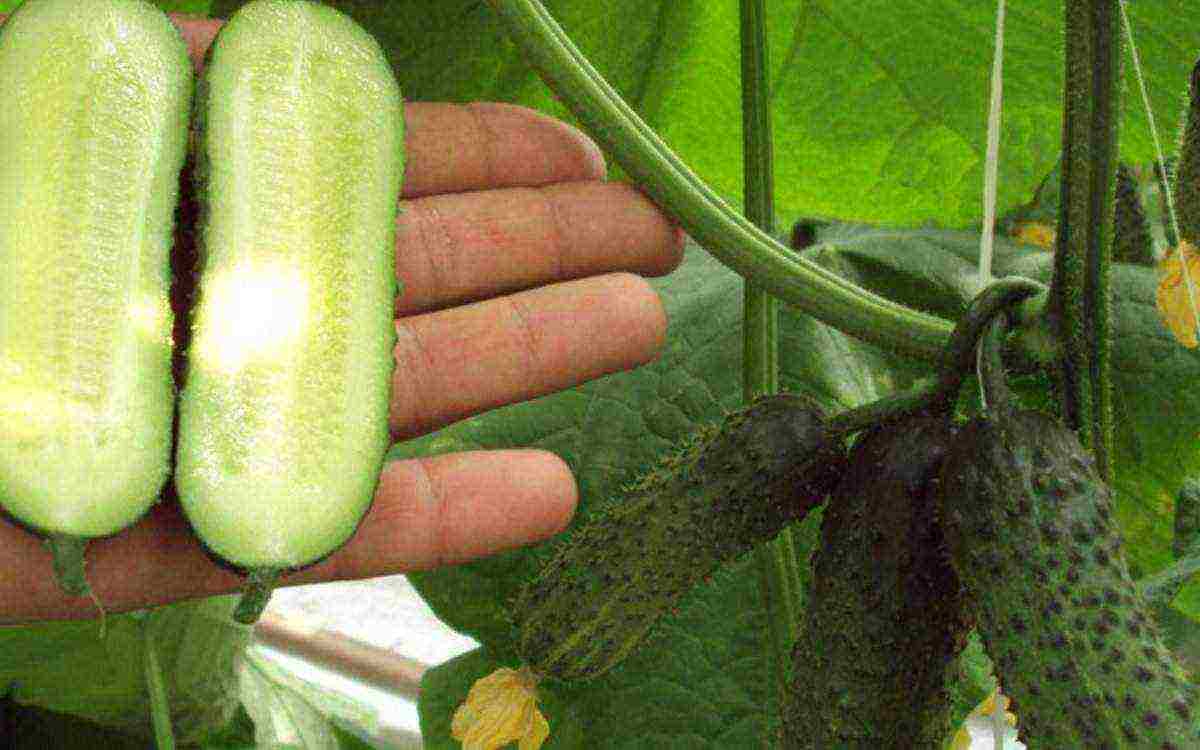
A wide step in the selection of cucumbers - to the ovary without pollination
Parthenocarp is the ability to form an ovary without pollination. Not to be confused with self-pollination, in which it is important to get pollen from the stamens onto the pistil, even if it occurs in one female flower. Parthenocarpic cucumbers, selected for industrial production, were liked by both private owners and owners of small land plots.
Gone is the need to take care of the indispensable neighborhood of insects, which will take the trouble to transfer pollen.
 It is necessary to know the parthenocarpic variety of cucumbers - what does this give to gardeners:
It is necessary to know the parthenocarpic variety of cucumbers - what does this give to gardeners:
- guaranteed formation of ovaries;
- consistently high result of seasonal collection;
- high immunity to most cultural diseases;
- amicable ripening of zelents;
- fruits without signs of overgrowth in the form of voids;
- complete absence of seeds inside, or a small number of them.
For residents of regions with a harsh climate, who are forced to grow vegetables only in greenhouses, parthenocarpic cucumbers are a real find.
Parthenocarpic cucumber hybrids for different types of cultivation
The varieties have an undeniable advantage over other hybrids. Along with those listed above, this is the absence of unpleasant bitterness (which is guaranteed in all weather conditions), and the similar size of all fruits, thanks to the massive yield of the crop. Modern parthenocarpic cucumbers for open ground and greenhouse cultivation are spreading by leaps and bounds throughout the country and already have their favorites.
Cucumbers Garland - a harvest for everyone to envy
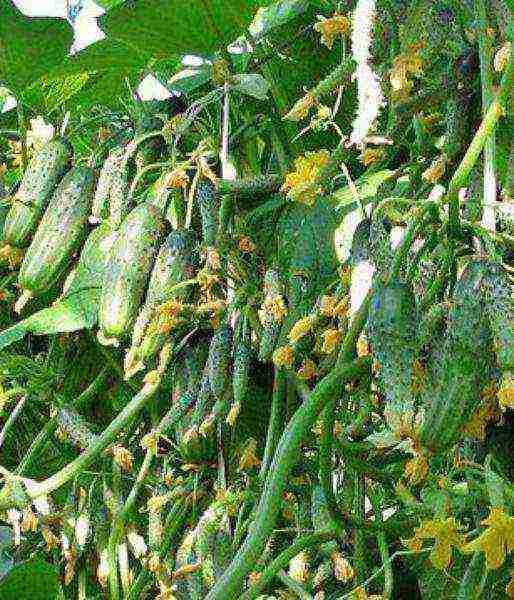 Since 2010, Garland cucumbers, the products of the Gavrish company of the Uralsky Dachnik series, have been known. This variety, undemanding to pollination, compares favorably with its shade tolerance.
Since 2010, Garland cucumbers, the products of the Gavrish company of the Uralsky Dachnik series, have been known. This variety, undemanding to pollination, compares favorably with its shade tolerance.
On the websites of gardeners, reviews of the Garland f1 cucumber contain the following characteristics:
- early ripe hybrid, fruiting in 40-45 days from sowing;
- excellent resistance to viral diseases;
- a bush of medium length, no more than 2 meters in the main stem;
- fruits are leveled, 100-150 grams, about 10-12 cm, with a small amount of small tender seeds.
The plant ties a whole bouquet in a knot, from 6 to 10 pieces in the form of a bunch of slightly lumpy white-thorn fruits, as the reviews say about cucumbers Garland f1 and about two hundred zelents are removed from one plant for envy. This is an excellent indicator of yield. To achieve it, a bush is formed into one stem, performing the following manipulations:
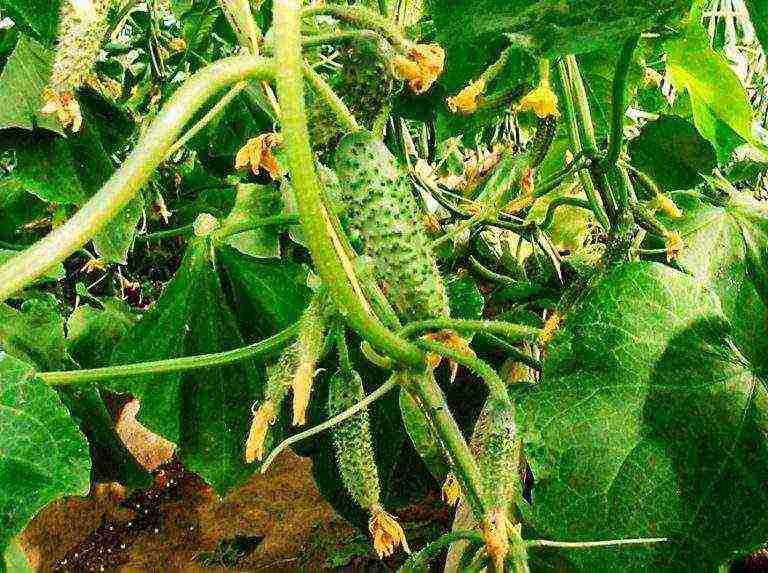 up to the fifth leaf on the main stem, remove all lateral outgrowths and flowers;
up to the fifth leaf on the main stem, remove all lateral outgrowths and flowers;- up to a meter of growth, new shoots are pinched on the main stem, leaving a single leaf and ovary;
- after 1 -1, 2 m on the main shoot, lateral stems are allowed to grow, pinching them after the second leaf and the second ovary.
It is most convenient to form the formation on a trellis, allowing the left shoots to grow horizontally. Such a cucumber bush will very soon be completely hung with bunches of cucumbers, justifying the name of the variety.
It also bears fruit in a bouquet-like manner, there are reviews about RMT f1 cucumbers, like all hybrids of the Uralsky Dachnik series. On one plant, 20-30 zelents ripen at the same time. An early variety, 36-40 days to develop. Fruits are cylindrical, up to 100 grams, from 9 to 13 cm. You can read an article about Siberian garland cucumbers.
Gunnar F1 hybrid - super early cucumber
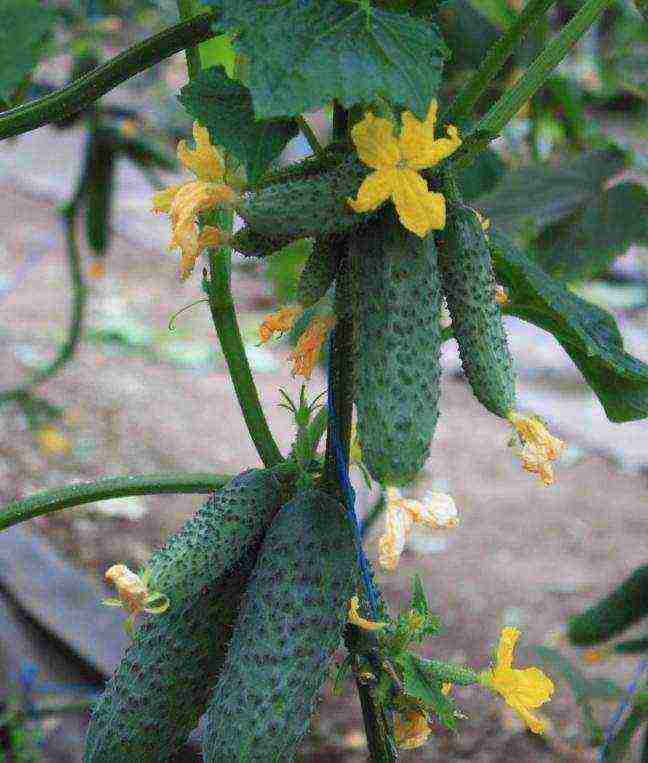 Cucumber Gunnar, a newcomer from Holland, appeared in the Russian seed register in 2014. In its segment of very early cultivars, it is classified as an ovary gherkin.
Cucumber Gunnar, a newcomer from Holland, appeared in the Russian seed register in 2014. In its segment of very early cultivars, it is classified as an ovary gherkin.
The varietal description of the Gunnar f1 cucumber promises results:
- the appearance of fruits after 35-38 days from the moment the sprout appears;
- formation of 2-4 ovaries in the node;
- white-thorn fruits, 120-150 grams each, without bitterness;
- the length of the cylindrical zelents is from 10 to 15 cm;
- harvest 19-25 kg from one square meter of area (or from two bushes).
The indicators declared on the package of seeds, according to the reviews about the Gunnar f1 cucumber, correspond to reality, subject to the agricultural technology of parthenocarpic hybrids:
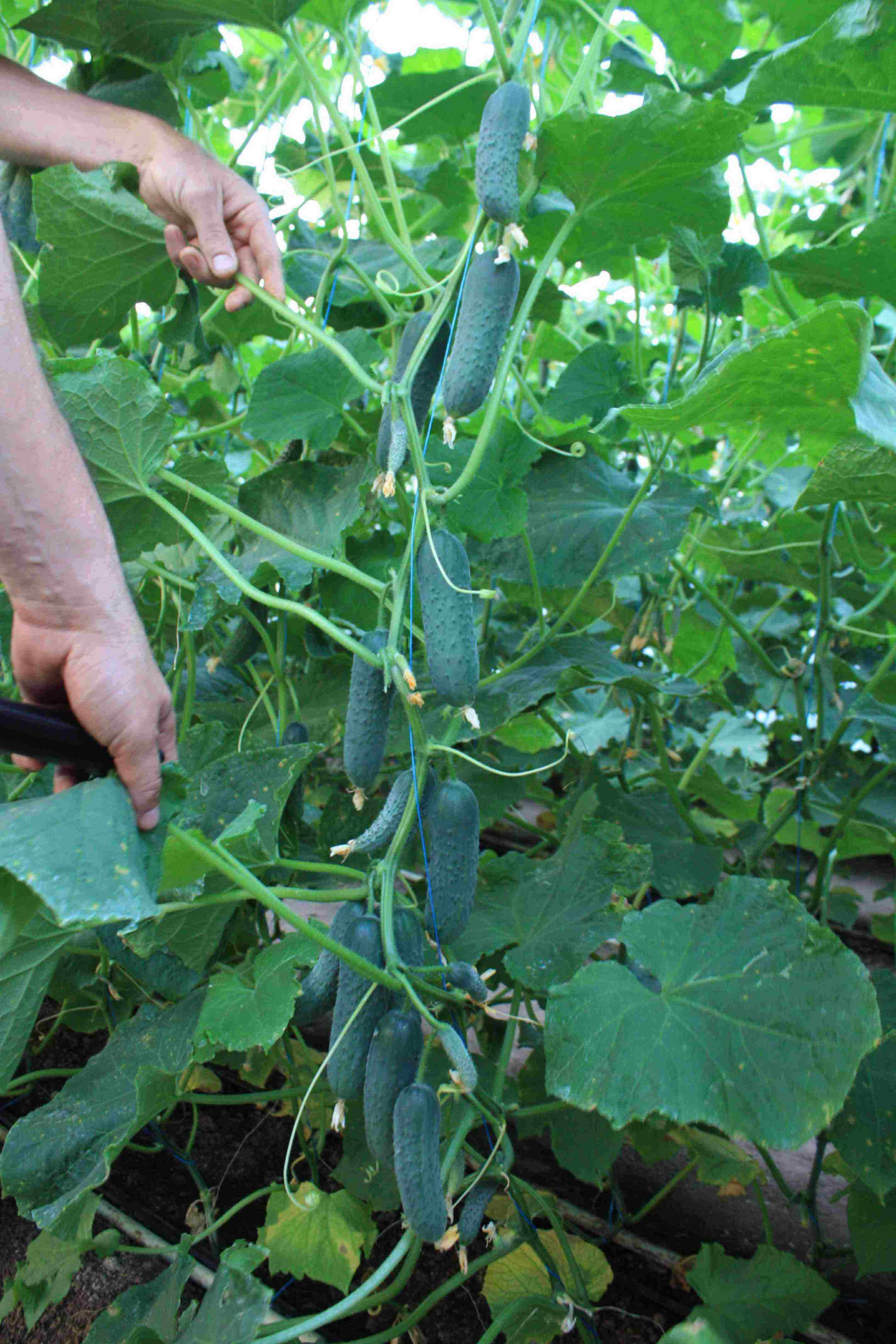 for one meter of area - no more than 2 bushes;
for one meter of area - no more than 2 bushes;- growing in greenhouses of any type;
- forming into one stem;
- support on a horizontal trellis.
Due to the fact that the fruiting of the variety is abundant and friendly, the crop should be cut at least 2 times a week, at the height of the season - every other day. Top dressing is carried out 1 time in 7 days with nitrogen-containing fertilizers.
The yield of hybrid cucumbers is increased in greenhouses saturated with carbon dioxide. To saturate a closed room with this necessary waste product, there is one trick: installing a container with grass soaked in water in a greenhouse. Due to their ultra-early maturity, Gunnar f1 cucumbers can be grown 2 times per season.
Cucumber Mother-in-law for greenhouses and open ground
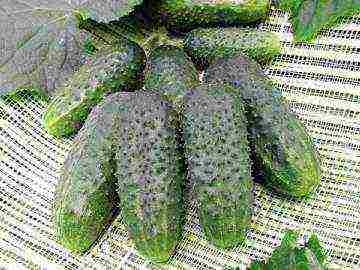 Mother-in-law's parthenocarpic cucumbers are suitable for growing not only in protected, but also in open ground. Vigorous bushes are light and heat-loving, therefore, not only the planting scheme (at a distance of 50 cm from each other) should be observed, but also the timing of planting seedlings. Numerous reviews of the mother-in-law f1 cucumber note that the yield of the variety with the seedling type of cultivation is higher than when sowing seeds directly into the ground. From germination of seeds to the first fruits, it takes 40-45 days, so for earlier harvesting, the seedlings begin to be prepared in April, and planted in the holes at the end of May, when the sprout forms 4-5 true leaves.
Mother-in-law's parthenocarpic cucumbers are suitable for growing not only in protected, but also in open ground. Vigorous bushes are light and heat-loving, therefore, not only the planting scheme (at a distance of 50 cm from each other) should be observed, but also the timing of planting seedlings. Numerous reviews of the mother-in-law f1 cucumber note that the yield of the variety with the seedling type of cultivation is higher than when sowing seeds directly into the ground. From germination of seeds to the first fruits, it takes 40-45 days, so for earlier harvesting, the seedlings begin to be prepared in April, and planted in the holes at the end of May, when the sprout forms 4-5 true leaves.
Formation into one stem leads to a stable and harmonious ripening. Many people know the description of the cucumber Mother-in-law f1: a dark green dense skin with white frequent thorns, a dense pulp structure, a small amount of seeds, a sweetish taste, a pronounced cucumber aroma. Fruits are on average 100-120 grams, grow in bunches of 3-4 pieces. The length of the gherkins is 10-13 cm. The yield of one plant is 6-9 kg.
Cucumber Real Colonel - for early picking
Indeterminate Cucumber This Colonel belongs to the early hybrid varieties. The amicable return of the crop begins in 40-45 days from the appearance of real shoots. Variety for any type of growing.
Hybrid cucumber The real colonel f1 is distinguished by a vigorous, weakly branched bush, resistant to cucumber mosaic viruses, cladosporia and root rot.
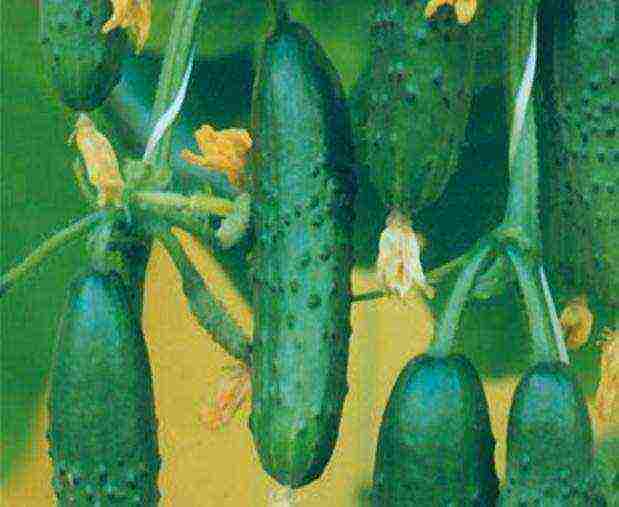 On horticultural sites, reviews of the cucumber Real Colonel f1 are positive, they note:
On horticultural sites, reviews of the cucumber Real Colonel f1 are positive, they note:
- good yield - from 3 to 7 kg per 1 sq. m;
- unpretentious care;
- high ability to set 1-3 greens in each leaf node;
- spindle-shaped fruits with large tubercles, bright green, with white thorns;
- length from 12 to 15 cm, diameter 30-40 mm, weight - 120-150 grams.
Ripe cucumber The real colonel has a bright cucumber aroma, sweet-herbaceous pleasant taste. In the case of improper agricultural technology, it can form voids inside the fruit. Harvesting regularly every 2-3 days will prevent this deficiency in the variety.
Claudius gherkins - a guarantee of a high harvest
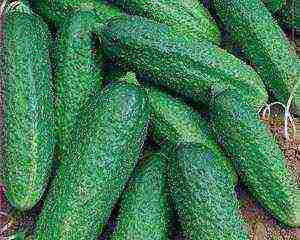 Popular mid-early cucumbers Claudia begin to delight with their harvest on the fiftieth day with the germination of seeds. The variety is suitable for almost any region of Russia, as it is a parthenocarpic hybrid for greenhouses and open ground. A brief description of the Claudia f1 cucumber: a medium-sized, weakly braided bush, a bouquet-type ovary is formed in the axils from 2 to 5 pieces, the fruits are leveled, small (9-10 cm, 60-90 g) with a small tuberous surface. The color of the gherkins is dark green with stripes. Taste without bitterness, structure - without voids, small seeds are small. Rave reviews about Claudia f1 cucumbers note the unusually high yield of the variety - from 20 kg per square meter of the garden. Excellent immunity to diseases, the ability to form an ovary in all weather conditions.
Popular mid-early cucumbers Claudia begin to delight with their harvest on the fiftieth day with the germination of seeds. The variety is suitable for almost any region of Russia, as it is a parthenocarpic hybrid for greenhouses and open ground. A brief description of the Claudia f1 cucumber: a medium-sized, weakly braided bush, a bouquet-type ovary is formed in the axils from 2 to 5 pieces, the fruits are leveled, small (9-10 cm, 60-90 g) with a small tuberous surface. The color of the gherkins is dark green with stripes. Taste without bitterness, structure - without voids, small seeds are small. Rave reviews about Claudia f1 cucumbers note the unusually high yield of the variety - from 20 kg per square meter of the garden. Excellent immunity to diseases, the ability to form an ovary in all weather conditions.
Two flys in the ointment of the benefits of hybrid cucumbers
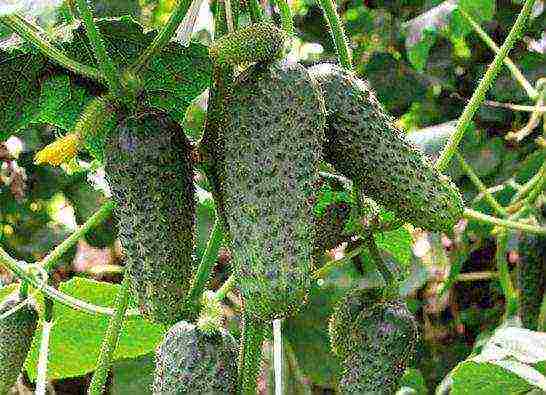 Parthenocarpic hybrids, with all their many advantages, have a couple of significant disadvantages. Fruits rich in vitamins and minerals are suitable only for fresh consumption, most varieties are not suitable for pickling and canning. So the eating of the grown abundance will have to be done in a short time. Vegetables are stored for several weeks.
Parthenocarpic hybrids, with all their many advantages, have a couple of significant disadvantages. Fruits rich in vitamins and minerals are suitable only for fresh consumption, most varieties are not suitable for pickling and canning. So the eating of the grown abundance will have to be done in a short time. Vegetables are stored for several weeks.
Another disadvantage is that, like all non-varietal varieties, hybrids are not able to give seeds suitable for the new season. Seed material will have to be purchased regularly, its price on the market is slightly higher than that of other representatives of the culture. However, you should definitely pay attention to these varieties. In any year, even not too favorable for cucumbers, so many fruits are formed on parthenocarpic bushes that this compensates for all material and physical costs. Also read the article: Which self-pollinated cucumber varieties are considered the best for cultivation?
An experienced gardener is unlikely to have a question what this is a parthenocarpic cucumber variety. The specific term on the package with seeds confuses beginners, those who have just recently started a summer cottage and built a greenhouse on it.
What is parthenocarpic cucumber
If we translate the word parthenocarp from the Greek language, then it will mean "virgin fetus". In a simple way, the fruit is obtained without the participation of the pollen of the male flower, that is, without pollination.
If you cut parthenocarpic zelenets, then on the cut there may be no seeds at all or they will be very smallnot formed. With the advent of cucumbers of this type, a new stage in the development of greenhouse farms began. The need for pollination has disappeared.
Quite recently, hives with bees were placed in industrial greenhouses; now they are not needed. Choosing the right cultivar for the greenhouse solves the problem.
The fruits are formed without pollination.
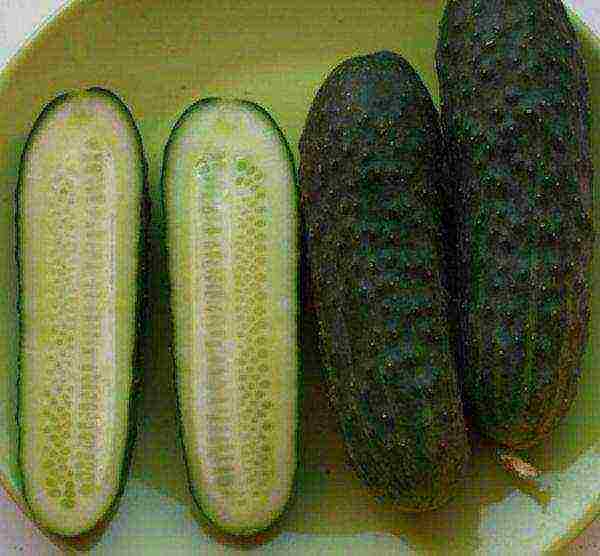 The seeds in the fruits of parthenocarpic cucumbers are very small
The seeds in the fruits of parthenocarpic cucumbers are very small
Advantages and disadvantages of cucumbers
Let us first evaluate the advantages that a summer resident will have who planted parthenocarpic cucumbers. The first plus is yield... In bee-pollinated varieties, it depends on insects, in self-pollinated varieties, it depends on the weather and insects. The yield is affected by low illumination, excessive soil moisture.
Parthenocarpic varieties show stable yields regardless of pollinator insects and weather conditions. You can plant cucumbers under the covering material, the fruits will be successfully formed in complete isolation.
These varieties are successfully grown:
- In the apartment on the windowsill.
- On the loggia.
- In the greenhouse.
- Outdoors.
- Under temporary cover.
 The main advantage is high yield
The main advantage is high yield
The second plus is taste and quality of fruits... Due to the lack of seeds, the pulp has a pleasant tender structure, the same density. There is no bitterness in cucumbers. Zelentsy are excellent raw materials for the production of canned vegetables.
Summer salads from young zelentsy look appetizing, tasty and fragrant.
The best varieties
As always, in the spring, the search for suitable varieties begins. I want to have an early harvest without much hassle. Consider several proven parthenocarpic varieties.
Pasamonte F1 - hybrid, yields early. A little more than a month (35 days) passes from the emergence of seedlings to the removal of the first cucumber. Cucumbers can be pickled. They are great in salads. Seeds undergo special processing before packaging, so they can be sown without prior preparation.
Emelya F1 - a hybrid that will delight you with productivity and excellent immunity. Even in unfavorable conditions, it gives a full-fledged harvest of cucumbers (15 cm) with an even, green color. The first wave of the harvest 40 days after germination.
Herman F1 - a hybrid with a stable yield, little susceptible to infections. Fruits with white thorns are formed in 7-8 pieces in a bunch, have the same size (3 * 12cm). The appointment is universal. The first cucumbers ripen in 40 days.
Features of growing in open and protected ground
Parthenocarpic cucumbers are best grown in a polycarbonate greenhouse... In protected ground conditions, it is easier to care for cucumbers with a bunch type of fruiting. Maintain the optimum temperature and the required air humidity.
Planting seeds
Seeds can be planted directly into the ground or sown in peat cups for seedlings. The germination of purchased seeds is not guaranteed, therefore 2-3 dry seeds or 1 hatched seed are planted in the hole (glass).
Bushes grow vigorous, require good lighting and nutrition. Place the holes 50 cm apart. The rows should be at least 1 m apart, the best distance between the rows is 1.5 m.
Dig up the soil before planting, add a quarter of a bucket of humus, ½ glass of ash to each hole. The soil must warm up before planting seeds.
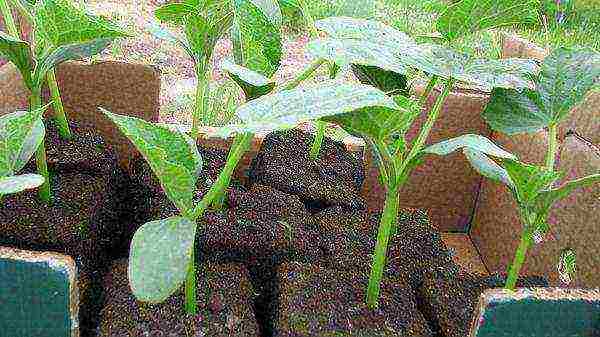 Planting is possible both by seeds in the ground and through seedlings
Planting is possible both by seeds in the ground and through seedlings
Seeds will not sprout if the temperature at a depth of 12 cm less than 15 degrees... The garden bed should be covered with PVC foil. The film will retain moisture in the soil, this will accelerate seed germination.
Care for the first shoots
When the first shoots appear, remove the film and replace it with covering material. During the day it can be removed, and at night it can be thrown on young shoots. Between the holes it is worth putting 1.5-5 liters of plastic water bottles.
During the day, the water heats up, and at night it gives off heat and maintains the air temperature. During this period, abundant watering is not needed. The ground should be moderately moist... Take warm, settled water for irrigation.
Watering and weeding
If you have planted cucumbers, then get ready for them water every 3 days... During the period of active fruiting and hot weather, every 2 days. Defend the water before watering. It should be warm. One watering can should be enough for 2 plants.
Weeding will also take time. Will help mulch - a layer of dry grass (10-15 cm) will cover the soil and reduce the amount of weeds on the ridge. Mulch will also reduce moisture evaporation and reduce the likelihood of the frequent cucumber disease - powdery mildew.
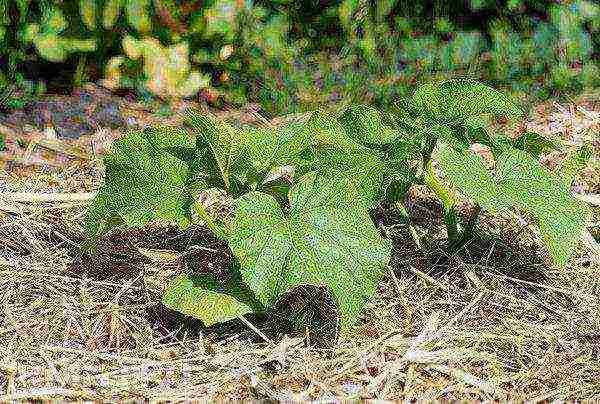 Mulch around parthenocarpic cucumbers will reduce weeds
Mulch around parthenocarpic cucumbers will reduce weeds
This type of cucumber responds well to all types of dressings (root, foliar). Before the beginning of fruiting, feed with herbal infusion, mullein infusion or ammonium nitrate solution once every 7-10 days.
During the formation of the fruit crop, phosphorus-potassium fertilizers are useful.
In bad weather - foliar dressing:
- milk with iodine;
- water plus boric acid.
Pinching and feeding
Pinch central stem of parthenocarpic cucumbers not necessary... This is a feature of this species.In self-pollinated and bee-pollinated species, you need to pinch the main stem over the 5th leaf.
But it is imperative to pluck out all the ovaries and flowers in each of the 4 lower sinuses. This technique is called blindness... The goal, which is pursued in this case, is to direct nutrients to the development of the plant.
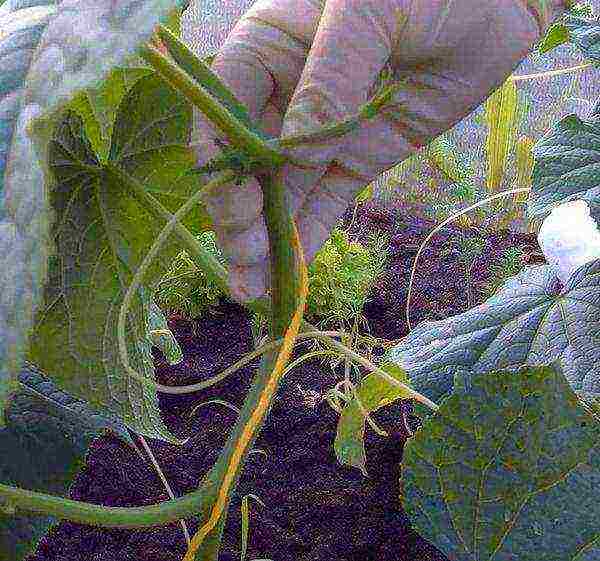 Blinding is a mandatory procedure for parthenocarpic varieties
Blinding is a mandatory procedure for parthenocarpic varieties
Bush formation
A stem is tied to the trellis after the appearance of 4 leaves... As it grows, you need to form a bush:
- From a height of 0.5 m to 1.5 m, pinch the shoots over 2 leaves.
- After 1.5 m - over 4 sheets.
- When the top of the stem reaches the top of the trellis, throw it over the top wire.
- At a distance of 0.6 m from the ground, pinch the top of the main stem.
Harvesting and storage
Every two days you need to inspect the cucumber lashes and pick cucumbers.
In this case, the zelents do not outgrow, the formation of new ovaries is accelerated. It turns out that the timely collection of fruits helps to increase yields... Store the harvested cucumbers in a cool, dark place or in the refrigerator.
It is worth purchasing parthenocarpic cucumber varieties for your summer cottage economy. A rich harvest of zelents will be provided by: the correct planting scheme, timely feeding and measures for the formation of a bush.
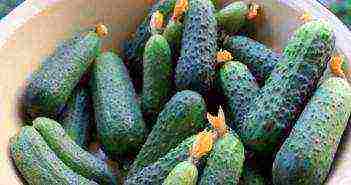
Parthenocarpic cucumber varieties, which are in demand for any summer resident, have relatively recently appeared among the traditional for growing garden crops. There are a lot of advantages of such a vegetable, but it also has its own nuances, therefore, before buying, you must definitely read the information below.
What are parthenocarpic cucumber hybrids, their features and differences from traditional and self-pollinated varieties, as well as a brief description of the most popular species - all information is in our article.
What pickling varieties of cucumbers for open ground are best used can be found in this article.
What are they

What does this mean? Breeding work on the development of new cultivated varieties of vegetables and fruits has been going on for a long time. The beginning of such experiments can be safely called the first experiments on the "domestication" of wild plants.
The history of the appearance of cucumbers in our everyday life has long been lost for centuries, it is not even known exactly when they began to grow it at home. According to some sources, this happened no earlier than four thousand years ago.
Nowadays cucumbers are one of the most beloved garden crops. The widespread distribution of which is fully caused by the excellent taste and the possibility of preparing for future use from this extraordinary vegetable. At the same time, the cultivation of cucumbers is associated with certain difficulties, in particular, sometimes it is not possible to create the possibility of sufficient pollination of flowers, which leads to a decrease in fertility. Some varieties of cucumbers can give a "surprise" - to let the barren flowers without the slightest chance of harvest.
What gherkin cucumbers look like for open ground is indicated in the article.
On the video - parthenocarpic cucumbers for open ground:
To get rid of such options, special hybrids - parthenocarps - were bred by selection. The main advantage of such cucumbers will be the ability to form ovaries without pollination. The plant produces exclusively female species of flowers, so it does not need additional pollinators.
This article indicates whether it is possible to plant cucumbers after cucumbers in your garden.
These hybrids are great for growing in greenhouse conditions. For open ground, cucumbers with such properties are also used, especially if weather conditions or other factors interfere with the work of pollinating insects.
Difference from self-pollinated
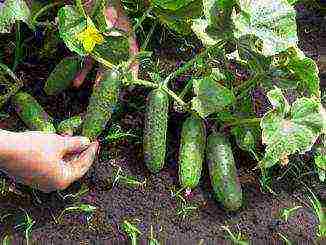
Most gardeners, one way or another, confuse these two concepts. Despite a similar result, both varieties have nothing to do with each other.The principle of "work" of self-pollinated cucumbers is that on the same flower there are male and female sexual characteristics, which determine the likelihood of a future ovary.
At the same time, only female flowers will be found on parthenocarpic varieties, therefore, fruit setting will occur without pollination and with a probability of 50 to 90%.
Which seeds of Partenocarpic cucumbers are used most often are indicated in this article.
Benefits of parthenocarpic varieties:
- Formation of ovaries without dependence on external factors.
- The ability to grow in various conditions - greenhouses or open ground.
- Resistant to culture-specific diseases.
- Excellent taste, lack of bitterness and hollowness of the fruit.
- High productivity.
All these positive qualities also influence the popularity of the varieties. Most of these fruits are highly valued for their taste characteristics, are suitable for fresh consumption and for all types of home storage and canning.
You can find out about how cucumber seedlings are grown in a greenhouse from this article.
A quick overview of popular designs
The range of such hybrids is quite wide, in addition, there is already real evidence that this method really works and allows you to get a good harvest. Among the parthenocarpic cucumbers, there is also a classification into early maturing, pickling and high-yielding varieties. When buying, you should definitely take this factor into account, because otherwise the chances of success will be lower.
How cucumbers are grown in slotted bags is shown here.
Varieties of parthenocarpic cucumbers for open ground:
- «Fun company F1 " - an early ripening hybrid. Fruits are small, rounded, with an average size of 9 to 13 centimeters. Differs in high taste characteristics, without characteristic bitterness and yellowness. Suitable for salting and fresh consumption. Resistant to common diseases and pests. The fruits ripen within 43 - 48 days after planting.
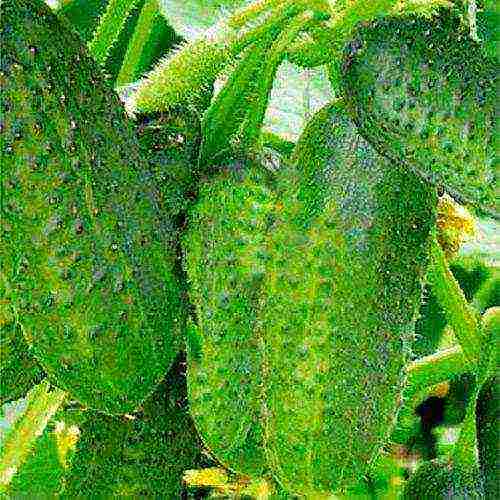
- «Zozulya F1"- a highly productive variety, more suitable for sheltering structures. Suitable for planting in open ground in warm enough climates. Fruits are cylindrical in shape, from 14 to 22 centimeters long. Mid-season, harvest can be obtained within 45 - 50 days after planting. Usually grown as a salad type of cucumber with a relatively long shelf life and the ability to be transported over long distances without compromising the presentation. Suitable for pickling with a short storage cycle, cannot be canned with other varieties, otherwise there is a high risk of spoilage of pickles.
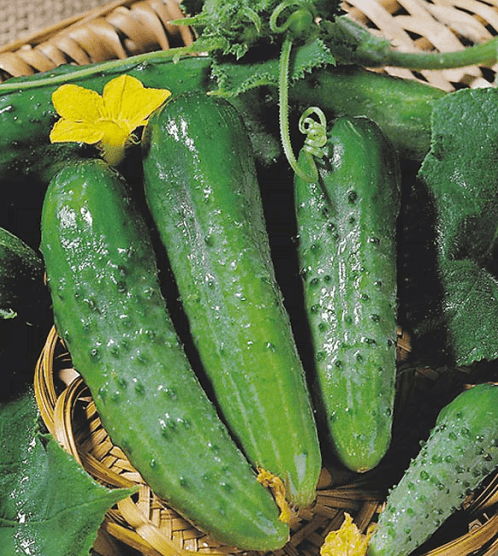
- «Chinese miracle"- a relative novelty in the domestic market. Very long fruits that reach 45 centimeters. Can be used for canning, while cucumbers are perfectly stored even when cut into pieces. They tolerate transportation well and do not contain the characteristic cucumber bitterness. Quite an interesting and unpretentious variety, resistant to common diseases.
The article lists all yielding varieties of cucumbers for open ground.
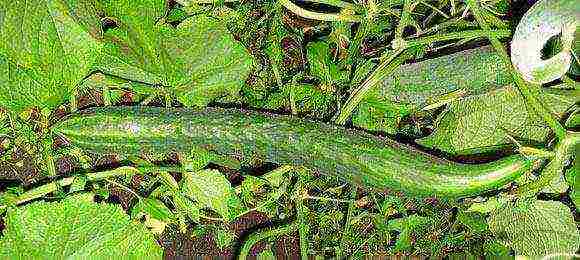
- «Claudia F1"- a mid-season hybrid of the parthenocarpic type. Fruit ripening period is about 50 - 52 days after planting in open ground. Cucumbers are characterized by a rounded shape of small length (10 - 12 centimeters) without bitterness. Excellent taste characteristics, well stored and transported, very resistant to diseases. As a rule, the harvest is immediately abundant, the average length remains at the level of the gherkins, without overgrowths. The fruits are suitable for all types of homemade preparations and are tasty when eaten fresh.
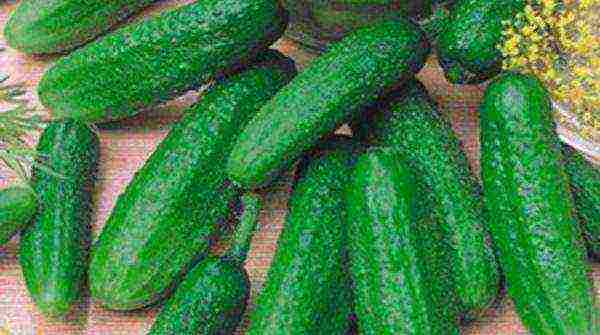
- «Baby - sturdy man F1 "- a novelty, specially developed taking into account possible low temperatures. Medium early variety, ripening period from 53 to 59 days. The length of the fruit is small, 7 - 8 centimeters.Cucumbers are devoid of bitterness and voids inside, a high degree of resistance to most characteristic diseases. A versatile variety, suitable for fresh consumption and canning.
How to use Masha f1 cucumber seeds correctly, you can find out by reading the article.

You can find out what Herman f1 cucumber seeds look like from the article.
To ensure a good harvest, it is best to use different types of parthenocarpic cucumbers. Cultivation can be done in seedlings, and in warm climates, sowing directly into the ground is possible. Tall cucumbers need a garter or support, and in general, caring for parthenocarpic cucumbers is not much different from growing other varieties.
What are the secrets of growing cucumbers in the open field, you can find out from the article.
A good harvest, regardless of natural whims, is the dream of most gardeners. Unfortunately, many factors affect the productivity of the site, up to the presence of insects that can pollinate the plants. If this is not the first time you have faced this problem, it may be time to think about purchasing parthenocarpic cucumber varieties. The big advantage of such a purchase will be the guarantee of the ovaries, even without third-party intervention. The main varieties of parthenocarpic cucumbers and their differences from self-pollinated plants are given in our article.

